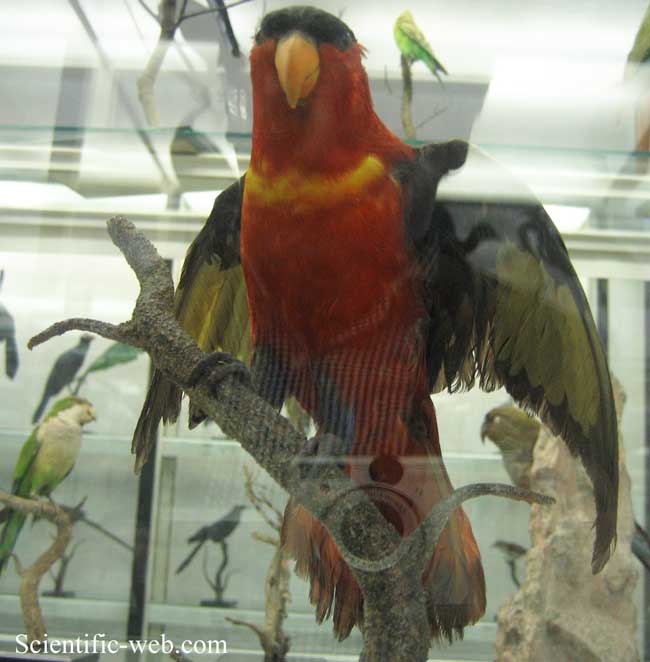
Lorius domicella, Photo: Michael Lahanas
Superregnum: Eukaryota
Cladus: Unikonta
Cladus: Opisthokonta
Cladus: Holozoa
Regnum: Animalia
Subregnum: Eumetazoa
Cladus: Bilateria
Cladus: Nephrozoa
Superphylum: Deuterostomia
Phylum: Chordata
Subphylum: Vertebrata
Infraphylum: Gnathostomata
Megaclassis: Osteichthyes
Cladus: Sarcopterygii
Cladus: Rhipidistia
Cladus: Tetrapodomorpha
Cladus: Eotetrapodiformes
Cladus: Elpistostegalia
Superclassis: Tetrapoda
Cladus: Reptiliomorpha
Cladus: Amniota
Classis: Reptilia
Cladus: Eureptilia
Cladus: Romeriida
Subclassis: Diapsida
Cladus: Sauria
Infraclassis: Archosauromorpha
Cladus: Crurotarsi
Divisio: Archosauria
Cladus: Avemetatarsalia
Cladus: Ornithodira
Subtaxon: Dinosauromorpha
Cladus: Dinosauriformes
Cladus: Dracohors
Cladus: Dinosauria
Cladus: Saurischia
Cladus: Eusaurischia
Subordo: Theropoda
Cladus: Neotheropoda
Cladus: Averostra
Cladus: Tetanurae
Cladus: Avetheropoda
Cladus: Coelurosauria
Cladus: Tyrannoraptora
Cladus: Maniraptoromorpha
Cladus: Maniraptoriformes
Cladus: Maniraptora
Cladus: Pennaraptora
Cladus: Paraves
Cladus: Eumaniraptora
Cladus: Avialae
Infraclassis: Aves
Cladus: Avebrevicauda
Cladus: Pygostylia
Cladus: Ornithothoraces
Cladus: Ornithuromorpha
Cladus: Carinatae
Parvclassis: Neornithes
Cohors: Neognathae
Cladus: Neoaves
Cladus: Telluraves
Cladus: Australaves
Ordo: Psittaciformes
Familia: Psittaculidae
Genus: Lorius
Species: Lorius domicella
Name
Lorius domicella (Linnaeus, 1758)
Original combination: Psittacus domicella
References
Linnaeus, C. 1758. Systema Naturae per regna tria naturæ, secundum classes, ordines, genera, species, cum characteribus, differentiis, synonymis, locis, Tomus I. Editio decima, reformata. Holmiæ: impensis direct. Laurentii Salvii. i–ii, 1–824 pp DOI: 10.5962/bhl.title.542: 100. Open access Reference page.
IUCN: Lorius domicella (Endangered)
Vernacular names
català: Lorius domicella
Cymraeg: Lori warbiws
Deutsch: Erzlori
English: Purple-naped Lory
español: Lori damisela
suomi: Sininiskaluri
français: Lori des dames
magyar: Feketefejű lóri
italiano: Lori nucaviola
മലയാളം: പർപ്പിൾ-നാപേഡ് ലോറി
Nederlands: Vrouwenlori
Diné bizaad: Tsídii yáłtiʼí yázhí bitsiiyah tsédídéhígíí
русский: Пурпурношапочный широкохвостый лори
svenska: purpurnackad lorikit
తెలుగు: ఊదా మెడ లోరీ
Türkçe: Mor enseli lori
The purple-naped lory (Lorius domicella) is a species of parrot in the family Psittaculidae.[2] It is forest-dwelling endemic to the islands of Seram, Ambon, and perhaps also Haruku and Saparua, South Maluku, Indonesia. It is considered endangered, the main threat being from trapping for the cage-bird trade.
Taxonomy
The purple-naped lory was formally described by the Swedish naturalist Carl Linnaeus in 1758 in the tenth edition of his Systema Naturae under the binomial name Psittacus domicella.[3] The specific epithet domicella is Medieval Latin meaning "damsel".[4] Linnaeus based his description on "The second Black-capped Lory" that had been described and illustrated in 1751 by the English naturalist George Edwards in his book A Natural History of Uncommon Birds. The specimen had been brought to London from the East Indies and Edwards was able made a drawing of it at the home of the naturalist and collector Hans Sloane.[5] Linnaeus specified the locality as "Asia", but this is now taken to be Ambon Island in the Maluku Islands.[6] The purple-naped lory is now placed in the genus Lorius that was introduced in 1825 by the Irish zoologist Nicholas Aylward Vigors.[7][8] The species is monotypic: no subspecies are recognised.[8]
Description
On the Banda Islands, Indonesia
Lorius tibialis, which was either an extinct species or just an aberrant form of Lorius domicella
The purple-naped lory is 28 cm (11 in) long. It is mostly red with an all red tail that fades to darker red towards the tip. The top of its head is black, which fades to purple on the back of its neck. It has green wings, blue thighs, and a variable approximately transverse yellow band across the chest. It has an orange beak, dark-grey eyerings, and orange-red irises. Juveniles have a brown beak, grey-white eyerings, brown irises, a wider yellow band across the chest, and a more extensive purple patch on the back of neck.[9]
References
BirdLife International (2016). "Lorius domicella". IUCN Red List of Threatened Species. 2016: e.T22684586A93036702. doi:10.2305/IUCN.UK.2016-3.RLTS.T22684586A93036702.en. Retrieved 13 November 2021.
"Zoological Nomenclature Resource: Psittaciformes (Version 9.022)". zoonomen.net. 28 March 2009.
Linnaeus, Carl (1758). Systema Naturae per regna tria naturae, secundum classes, ordines, genera, species, cum characteribus, differentiis, synonymis, locis (in Latin). Vol. 1 (10th ed.). Holmiae (Stockholm): Laurentii Salvii. p. 100.
Jobling, James A. (2010). The Helm Dictionary of Scientific Bird Names. London: Christopher Helm. p. 138. ISBN 978-1-4081-2501-4.
Edwards, George (1751). A Natural History of Uncommon Birds. Vol. Part IV. London: Printed for the author at the College of Physicians. p. 171.
Peters, James Lee, ed. (1937). Check-List of Birds of the World. Vol. 3. Cambridge, Massachusetts: Harvard University Press. p. 155.
Vigors, Nicholas Aylward (1825). "On the arrangement of the genera of birds". Zoological Journal. 2: 391–405 [400].
Gill, Frank; Donsker, David; Rasmussen, Pamela, eds. (July 2021). "Parrots, cockatoos". IOC World Bird List Version 11.2. International Ornithologists' Union. Retrieved 25 July 2021.
Forshaw, Joseph M. (2006). Parrots of the World; an Identification Guide. Illustrated by Frank Knight. Princeton University Press. Plate 17. ISBN 0-691-09251-6.
Retrieved from "http://en.wikipedia.org/"
All text is available under the terms of the GNU Free Documentation License

